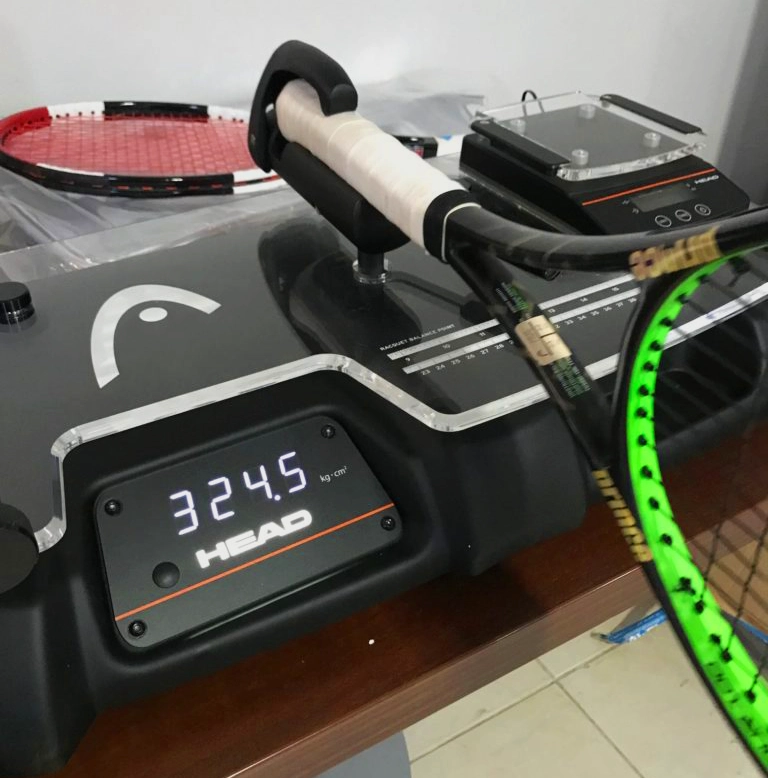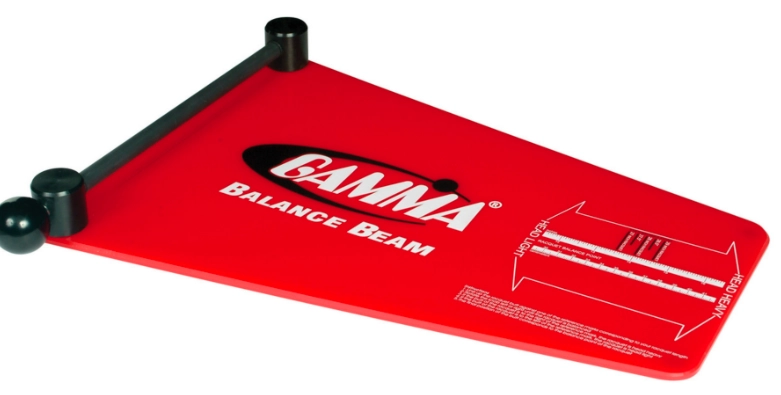One key information when customizing and choosing a tennis racquet is the balance of the racquet. In this post we’ll deal with tennis racquet balance points and clarify how it works.
Tennis Racquet Balance Points
This is what Tennis Warehouse writes on the subject of tennis racquet balance points:
“Static measure of weight distribution in a racquet and measured from the butt end in inches and/or centimeters. Commonly referenced in “points” head-light or head heavy – each “point” represents 1/8 inch. Generally speaking, heavier racquets are head-light to maintain maneuverability, while most of today’s super-light racquets are head heavy to supply enough mass (which translates into power) to the area of the frame where the ball is being contacted.“
I think the above statement is important because this is the case with most tennis racquets. A heavy racquet is usually head-light, take the Wilson Six One 95 for example which weighs 332 grams and is 12 pts head light unstrung. If that racquet was at an even balance it would be a beast to swing (high swing weight)! Most modern racquets today need to be relatively easy to swing since tennis is becoming increasingly fast-paced and to compensate for the lighter racquet, more weight is placed in the head of the racquet so the racquet won’t twist too easily at impact with the ball.
How swing weight impacts the racquet

To clarify how swing weight impacts the racquet: a lower swing weight results in greater racquet acceleration and final swing speed, but more shock (due both to more racquet deceleration by the ball and higher impact force due to greater speed). Higher swing weight results in slower racquet acceleration and final swing speed but less shock due to less deceleration due to the ball pushing the racquet in opposite circular rotation.
So if you want the ball to really “pancake” on the racquet, make sure your racquet has a decent amount of weight in the head. If you like to swing fast and are good at getting massive racquet head speed, then you might not need the same amount of weight in the head and can play with lighter racquets or more head-light racquets.
I’m personally more in favor of heavier racquets because I like to “feel” the ball impact the string bed more and reducing my swing speed a bit helps me with my control. I have almost always played with racquets above 340 grams due to this, but I have played against advanced and competitive players who play amazingly well with racquets weighing 295 grams unstrung and no lead added! Different strokes for different folks, I guess.
More about using Heavy Racquets in the video below:
Back to balance points
But let’s go back to balance points. The concept is not too hard to understand. Even balance means that the racquet is evenly balanced from head to handle, if the racquet has more weight towards the handle it is head light, and more weight towards the head it’s head-heavy. That’s how simple it is. Finding your ideal weight and balance is where it gets tricky!
To properly measure your racquet’s balance you need a balance beam. You can either build one yourself (here’s a thread on TW forums) or buy one (I did this because I’m lazy). Here’s a table on tennis racquet balance points:
| Points | Inches | Centimeters |
| 0 | 13.5 | 34.290 |
| 1 | 13.375 | 33.973 |
| 2 | 13.25 | 33.655 |
| 3 | 13.125 | 33.338 |
| 4 | 13 | 33.020 |
| 5 | 12.875 | 32.703 |
| 6 | 12.75 | 32.385 |
| 7 | 12.625 | 32.068 |
| 8 | 12.5 | 31.750 |
| 8.5 | 12.4375 | 31.591 |
| 9 | 12.375 | 31.433 |
| 10 | 12.25 | 31.115 |
| 11 | 12.125 | 30.798 |
| 12 | 12 | 30.480 |
| 13 | 11.875 | 30.163 |
What balance do you prefer? Please comment below!
I’m currently using a HEAD Liquidmetal Radical Tour that weighs 355 grams strung and has a balance of 32 cm and it plays like a tank. I’m enjoying it, but essentially I’m using this racquet while I’m making my mind up between getting more Angell TC 97 Customs or a couple of the Wilson Ultra Tour. That’s the life of a racquetholic…
Since I’m in Europe, I bought my Gamma Viper Balance Beam at Racquetdepot.co.uk but you’ll also find it on Amazon. It’s really an essential tool for customizing your tennis racquets. While you’re at it, you might as well get some Tourna lead tape
.
Good luck with your racquet customizations!




14 comments
Glad you liked the Head Radical Liquidmetal Tour Jonas. Hits a heavy but controlled ball in my opinion. Too heavy for me to handle though, I prefer lighter but more even balanced racquets.
Cheers
Magnus
Thanks for your comment, Magnus. It’s a great racquet. Let’s see how long I stick with it…:)
in this table, is it HL points right? or HH?
thanks
Head light!
Hi, thanks :)
Wanted to ask you, if I need to put some weight to the grip, can I put some lead tape under the grip or should I open the but cup? I would prefer not to if necessary :S
Thanks
Where did your balance point table go?
It disappeared when I deactivated a plugin. It is back again!
Could you possibly take my full name off of my comment?
Did it for you
Thanks for the balance points chart! Good choices on the radical and the angell sticks.
My all time favorite baby is the Donnay x dual platinum 94, which is like playing your hand itself. Since grommets are no longer available for that, I have also gone to Angell. I use the v3 95, 11 oz, 7 pts HL. Been playing with weight in the buttcap, and I think I’ve gotten it to around 12pts HL. It’s starting to feel more like my Donnay ;)
I am trying to calculate swing weight manually. Could you make a video on how to calculate in terms of procedure. Not many videos are out there
Always great stuff, Tennis Nerd! Thanks for this and the very helpful conversion chart…
After rotator-cuff tear rehab back in 1998, I found myself playing 365-370gg 15-16 pts HL.
Over 20 years later, dealing with a more than year-long case of TE, I find around 345g and 7-8pts HL appears to give me better results…
Thanks, great that you have found your spec.
32.3 cm balance, 343 gr, wilson blade v7 18×20 added about 10gr silicone inside the heandle.